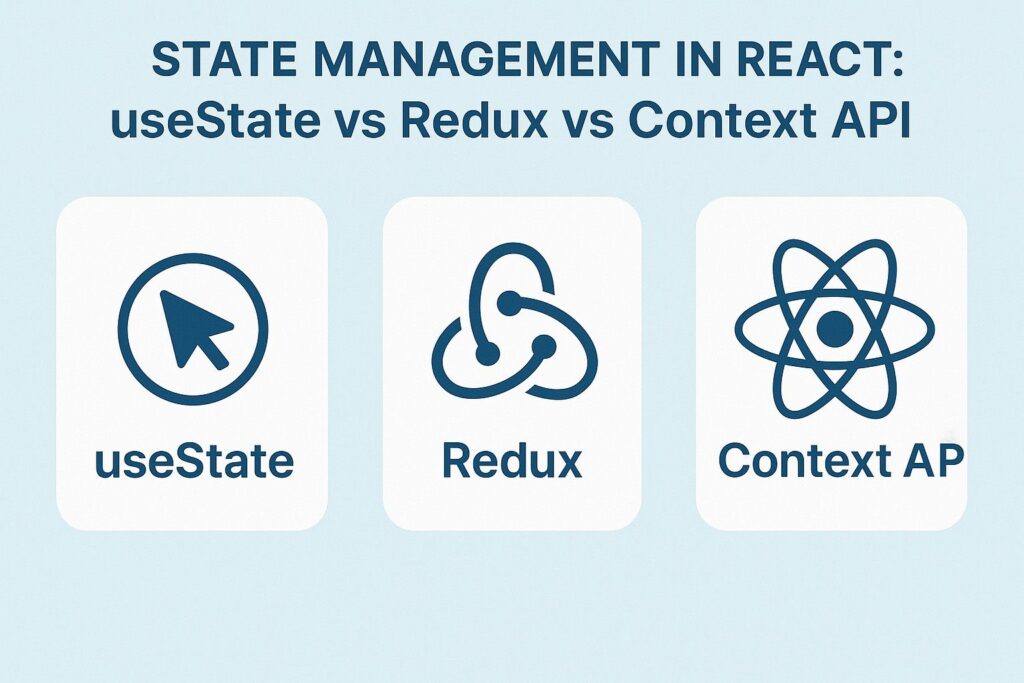
In modern web applications, state management is at the heart of every dynamic and interactive experience. Whether it’s managing form inputs, toggling UI elements, storing user preferences, or syncing data across multiple components—handling state efficiently can significantly impact your application’s scalability, maintainability, and performance.
React, by design, encourages the use of internal component state via hooks like useState. However, as applications grow in complexity, developers often face challenges like prop drilling, performance bottlenecks, and global state synchronization. To tackle these issues, React provides multiple approaches, including the built-in Context API, and third-party solutions like Redux, which are designed to meet varying levels of complexity and architectural needs.
In this article, we’ll compare the three most common state management approaches: useState, Context API, and Redux—covering when to use them, how they work, and how they differ.
1. useState: The Go-To for Local State
useState is a built-in React Hook that allows functional components to hold local state.
import { useState } from 'react';
function Counter() {
const [count, setCount] = useState(0);
return <button onClick={() => setCount(count + 1)}>{count}</button>;
}Use Cases
- Local component-level state
- UI elements like forms, toggles, inputs
- State that doesn’t need to be shared between components
Pros
- Simple and lightweight
- Perfect for isolated state
- Encourages component reusability
Cons
- Not ideal for sharing state across deeply nested components
- Can lead to prop drilling when state is needed in multiple child components
2. Context API: For Sharing State Across Components
React’s Context API allows you to share state globally across components without manually passing props at every level.
const ThemeContext = React.createContext();
function App() {
return (
<ThemeContext.Provider value="dark">
<Toolbar />
</ThemeContext.Provider>
);
}
function Toolbar() {
return <ThemeButton />;
}
function ThemeButton() {
const theme = useContext(ThemeContext);
return <button>{theme}</button>;
}Use Cases
- Theme toggling (dark/light)
- User authentication status
- Language and localization settings
- Global UI settings (like modals or sidebars)
Pros
- Eliminates prop drilling
- Simple API for small-scale global state
- Built into React—no external dependencies
Cons
- Not optimized for frequent updates or large state
- Can cause unnecessary re-renders if used improperly
- Lacks advanced debugging and tooling
3. Redux: For Complex, Scalable Applications
Redux is a third-party library for managing global state using a unidirectional data flow. State is stored in a central store and updated via actions and reducers.
// Action
const increment = () => ({ type: 'INCREMENT' });
// Reducer
function counterReducer(state = 0, action) {
switch (action.type) {
case 'INCREMENT': return state + 1;
default: return state;
}
}Use Cases
- Large applications with complex state logic
- Apps requiring state persistence, undo/redo, or time-travel debugging
- When multiple components across different parts of the app need to access and modify the same state
Pros
- Predictable state flow and strict structure
- DevTools support for debugging and time-travel
- Middleware support for async logic (e.g., redux-thunk, redux-saga)
- Easily testable
Cons
- More boilerplate code
- Learning curve for newcomers
- Overhead for small applications
Key Differences At a Glance
| Feature | useState | Context API | Redux |
|---|---|---|---|
| Scope | Local | Global (limited scope) | Global (full app-wide) |
| Best for | Isolated state | Sharing simple global data | Large apps with complex state |
| Performance | Optimal | Can cause re-renders | Optimized with selectors |
| Setup Complexity | None | Low | High |
| Tooling/Debugging | Basic | Basic | Advanced with DevTools |
| Async Logic Support | Manual (useEffect) | Manual | Middleware like Thunk/Saga |
| Boilerplate | Minimal | Low | High |
When to Use Which
| Situation | Recommended Tool |
| Local form input or toggle state | useState |
| Sharing a theme or auth state app-wide | Context API |
| Managing complex state with async logic | Redux |
| Rapid prototyping or MVPs | useState + Context |
| Large-scale enterprise app with multiple teams | Redux or Zustand/Recoil |
Alternative Libraries to Consider
While Redux remains a mature and powerful tool, newer state management libraries provide simpler APIs with less boilerplate:
- Zustand – Minimalistic and scalable with React hooks
- Recoil – Atom-based state management that works well with React concurrent mode
- Jotai – Focuses on primitive and composable state units
These alternatives are great for those looking for simpler syntax without compromising flexibility.
Final Thoughts
State management is not a one-size-fits-all solution. The right tool depends on your application’s complexity, team size, performance requirements, and scalability goals.
- Start with
useStatefor simple, local state needs. - Introduce
Context APIwhen state needs to be shared across components. - Use
Redux(or modern alternatives like Zustand or Recoil) for large applications where predictable, centralized state management is critical.
As your project evolves, you might find yourself refactoring from one method to another. That’s perfectly fine—choosing the simplest effective tool is often the best strategy in React development.

I’m Shreyash Mhashilkar, an IT professional who loves building user-friendly, scalable digital solutions. Outside of coding, I enjoy researching new places, learning about different cultures, and exploring how technology shapes the way we live and travel. I share my experiences and discoveries to help others explore new places, cultures, and ideas with curiosity and enthusiasm.






